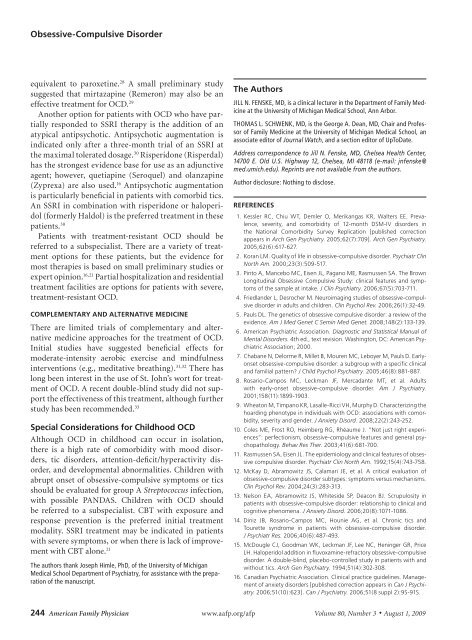Obsessive-Compulsive Disorder: Diagnosis and Management
Obsessive-Compulsive Disorder: Diagnosis and Management
Obsessive-Compulsive Disorder: Diagnosis and Management
Create successful ePaper yourself
Turn your PDF publications into a flip-book with our unique Google optimized e-Paper software.
<strong>Obsessive</strong>-<strong>Compulsive</strong> <strong>Disorder</strong>equivalent to paroxetine. 28 A small preliminary studysuggested that mirtazapine (Remeron) may also be aneffective treatment for OCD. 29Another option for patients with OCD who have partiallyresponded to SSRI therapy is the addition of anatypical antipsychotic. Antipsychotic augmentation isindicated only after a three-month trial of an SSRI atthe maximal tolerated dosage. 30 Risperidone (Risperdal)has the strongest evidence base for use as an adjunctiveagent; however, quetiapine (Seroquel) <strong>and</strong> olanzapine(Zyprexa) are also used. 16 Antipsychotic augmentationis particularly beneficial in patients with comorbid tics.An SSRI in combination with risperidone or haloperidol(formerly Haldol) is the preferred treatment in thesepatients. 30Patients with treatment-resistant OCD should bereferred to a subspecialist. There are a variety of treatmentoptions for these patients, but the evidence formost therapies is based on small preliminary studies orexpert opinion. 16,21 Partial hospitalization <strong>and</strong> residentialtreatment facilities are options for patients with severe,treatment-resistant OCD.COMPLEMENTARY AND ALTERNATIVE MEDICINEThere are limited trials of complementary <strong>and</strong> alternativemedicine approaches for the treatment of OCD.Initial studies have suggested beneficial effects formoderate-intensity aerobic exercise <strong>and</strong> mindfulnessinterventions (e.g., meditative breathing). 31,32 There haslong been interest in the use of St. John’s wort for treatmentof OCD. A recent double-blind study did not supportthe effectiveness of this treatment, although furtherstudy has been recommended. 33Special Considerations for Childhood OCDAlthough OCD in childhood can occur in isolation,there is a high rate of comorbidity with mood disorders,tic disorders, attention-deficit/hyperactivity disorder,<strong>and</strong> developmental abnormalities. Children withabrupt onset of obsessive-compulsive symptoms or ticsshould be evaluated for group A Streptococcus infection,with possible PANDAS. Children with OCD shouldbe referred to a subspecialist. CBT with exposure <strong>and</strong>response prevention is the preferred initial treatmentmodality. SSRI treatment may be indicated in patientswith severe symptoms, or when there is lack of improvementwith CBT alone. 21The authors thank Joseph Himle, PhD, of the University of MichiganMedical School Department of Psychiatry, for assistance with the preparationof the manuscript.The AuthorsJILL N. FENSKE, MD, is a clinical lecturer in the Department of Family Medicineat the University of Michigan Medical School, Ann Arbor.THOMAS L. SCHWENK, MD, is the George A. Dean, MD, Chair <strong>and</strong> Professorof Family Medicine at the University of Michigan Medical School, anassociate editor of Journal Watch, <strong>and</strong> a section editor of UpToDate.Address correspondence to Jill N. Fenske, MD, Chelsea Health Center,14700 E. Old U.S. Highway 12, Chelsea, MI 48118 (e-mail: jnfenske@med.umich.edu). Reprints are not available from the authors.Author disclosure: Nothing to disclose.REFERENCES1. Kessler RC, Chiu WT, Demler O, Merikangas KR, Walters EE. Prevalence,severity, <strong>and</strong> comorbidity of 12-month DSM-IV disorders inthe National Comorbidity Survey Replication [published correctionappears in Arch Gen Psychiatry. 2005;62(7):709]. Arch Gen Psychiatry.2005;62(6):617-627.2. Koran LM. Quality of life in obsessive-compulsive disorder. Psychiatr ClinNorth Am. 2000;23(3):509-517.3. Pinto A, Mancebo MC, Eisen JL, Pagano ME, Rasmussen SA. The BrownLongitudinal <strong>Obsessive</strong> <strong>Compulsive</strong> Study: clinical features <strong>and</strong> symptomsof the sample at intake. J Clin Psychiatry. 2006;67(5):703-711.4. Friedl<strong>and</strong>er L, Desrocher M. Neuroimaging studies of obsessive-compulsivedisorder in adults <strong>and</strong> children. Clin Psychol Rev. 2006;26(1):32-49.5. Pauls DL. The genetics of obsessive compulsive disorder: a review of theevidence. Am J Med Genet C Semin Med Genet. 2008;148(2):133-139.6. American Psychiatric Association. Diagnostic <strong>and</strong> Statistical Manual ofMental <strong>Disorder</strong>s. 4th ed., text revision. Washington, DC: American PsychiatricAssociation; 2000.7. Chabane N, Delorme R, Millet B, Mouren MC, Leboyer M, Pauls D. Earlyonsetobsessive-compulsive disorder: a subgroup with a specific clinical<strong>and</strong> familial pattern? J Child Psychol Psychiatry. 2005;46(8):881-887.8. Rosario-Campos MC, Leckman JF, Mercadante MT, et al. Adultswith early-onset obsessive-compulsive disorder. Am J Psychiatry.2001;158(11):1899-1903.9. Wheaton M, Timpano KR, Lasalle-Ricci VH, Murphy D. Characterizing thehoarding phenotype in individuals with OCD: associations with comorbidity,severity <strong>and</strong> gender. J Anxiety Disord. 2008;22(2):243-252.10. Coles ME, Frost RO, Heimberg RG, Rhéaume J. “Not just right experiences”:perfectionism, obsessive-compulsive features <strong>and</strong> general psychopathology.Behav Res Ther. 2003;41(6):681-700.11. Rasmussen SA, Eisen JL. The epidemiology <strong>and</strong> clinical features of obsessivecompulsive disorder. Psychiatr Clin North Am. 1992;15(4):743-758.12. McKay D, Abramowitz JS, Calamari JE, et al. A critical evaluation ofobsessive-compulsive disorder subtypes: symptoms versus mechanisms.Clin Psychol Rev. 2004;24(3):283-313.13. Nelson EA, Abramowitz JS, Whiteside SP, Deacon BJ. Scrupulosity inpatients with obsessive-compulsive disorder: relationship to clinical <strong>and</strong>cognitive phenomena. J Anxiety Disord. 2006;20(8):1071-1086.14. Diniz JB, Rosario-Campos MC, Hounie AG, et al. Chronic tics <strong>and</strong>Tourette syndrome in patients with obsessive-compulsive disorder.J Psychiatr Res. 2006;40(6):487-493.15. McDougle CJ, Goodman WK, Leckman JF, Lee NC, Heninger GR, PriceLH. Haloperidol addition in fluvoxamine-refractory obsessive-compulsivedisorder. A double-blind, placebo-controlled study in patients with <strong>and</strong>without tics. Arch Gen Psychiatry. 1994;51(4):302-308.16. Canadian Psychiatric Association. Clinical practice guidelines. <strong>Management</strong>of anxiety disorders [published correction appears in Can J Psychiatry.2006;51(10):623]. Can J Psychiatry. 2006;51(8 suppl 2):9S-91S.244 American Family Physician www.aafp.org/afp Volume 80, Number 3 ◆ August 1, 2009











